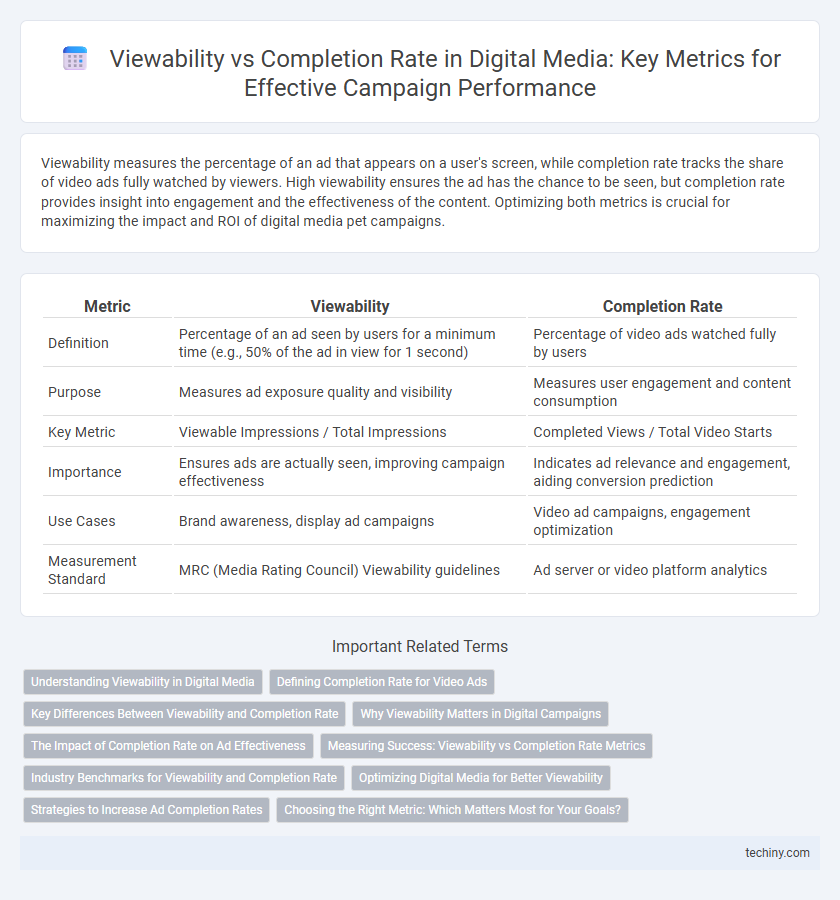Viewability measures the percentage of an ad that appears on a user's screen, while completion rate tracks the share of video ads fully watched by viewers. High viewability ensures the ad has the chance to be seen, but completion rate provides insight into engagement and the effectiveness of the content. Optimizing both metrics is crucial for maximizing the impact and ROI of digital media pet campaigns.
Table of Comparison
| Metric | Viewability | Completion Rate |
|---|---|---|
| Definition | Percentage of an ad seen by users for a minimum time (e.g., 50% of the ad in view for 1 second) | Percentage of video ads watched fully by users |
| Purpose | Measures ad exposure quality and visibility | Measures user engagement and content consumption |
| Key Metric | Viewable Impressions / Total Impressions | Completed Views / Total Video Starts |
| Importance | Ensures ads are actually seen, improving campaign effectiveness | Indicates ad relevance and engagement, aiding conversion prediction |
| Use Cases | Brand awareness, display ad campaigns | Video ad campaigns, engagement optimization |
| Measurement Standard | MRC (Media Rating Council) Viewability guidelines | Ad server or video platform analytics |
Understanding Viewability in Digital Media
Viewability in digital media measures the percentage of an ad that is visible to users, typically requiring at least 50% of the ad's pixels to be in view for a minimum of one second. Unlike completion rate, which tracks whether a video ad is watched in full, viewability focuses on actual exposure, ensuring advertisers pay for ads that have a chance to be seen. Higher viewability rates correlate with increased brand engagement and better campaign performance, making it a critical metric for digital advertisers.
Defining Completion Rate for Video Ads
Completion rate for video ads measures the percentage of viewers who watch the entire video ad from start to finish, indicating the ad's effectiveness in maintaining audience attention. Unlike viewability, which tracks whether an ad is detectable on screen, completion rate emphasizes full consumption, reflecting deeper engagement and potential impact on brand recall. High completion rates typically signal compelling content and successful targeting within digital media campaigns.
Key Differences Between Viewability and Completion Rate
Viewability measures the percentage of an ad that is visible to users on their screen for a minimum duration, while completion rate tracks the proportion of video ads watched from start to finish. Viewability emphasizes exposure and ad visibility metrics, providing insight into whether the ad had the opportunity to engage the audience. Completion rate reflects user engagement and effectiveness by indicating how many viewers watched the entire content, making it crucial for assessing the impact of video advertising campaigns.
Why Viewability Matters in Digital Campaigns
Viewability measures the percentage of an ad that is actually seen by users, directly impacting brand exposure and campaign effectiveness. High viewability ensures that ads have the opportunity to engage audiences, increasing the likelihood of message retention and action. Completion rate alone can be misleading without viewability data, as ads must be visible to drive meaningful consumer interactions and maximize ROI.
The Impact of Completion Rate on Ad Effectiveness
Completion rate significantly influences ad effectiveness by measuring the percentage of an ad fully viewed by users, reflecting genuine engagement beyond mere viewability metrics. Higher completion rates correlate with increased brand recall, message retention, and conversion rates, indicating that audiences are attentively consuming the entire ad content. Advertisers prioritize completion rate to optimize campaign performance, as it better predicts user response and ROI compared to basic viewability benchmarks.
Measuring Success: Viewability vs Completion Rate Metrics
Viewability measures the percentage of ad impressions actually seen by users, while completion rate tracks the proportion of video ads fully watched, both crucial for evaluating digital media campaign performance. Higher viewability ensures ads reach audiences effectively, whereas a strong completion rate indicates engagement quality and content relevance. Combining these metrics provides a comprehensive understanding of ad impact and helps optimize media strategies for better ROI.
Industry Benchmarks for Viewability and Completion Rate
Industry benchmarks for digital media reveal an average viewability rate of approximately 70%, indicating that ads are fully visible on users' screens for a significant portion of their duration. Completion rates, which measure the percentage of ads watched in full, typically range between 50% and 75%, with video ad length and format strongly influencing these figures. Brands optimizing campaigns aim to exceed the 70% viewability benchmark to enhance ad efficiency and maximize audience engagement.
Optimizing Digital Media for Better Viewability
Optimizing digital media for better viewability involves prioritizing ad placements where at least 70% of the ad remains in view for a minimum of one second, aligning with IAB standards. Enhancing viewability directly impacts completion rates by ensuring ads are fully seen, which increases user engagement and campaign effectiveness. Utilizing programmatic tools and real-time analytics allows marketers to adjust bids and creatives dynamically, improving both viewability metrics and overall digital ad performance.
Strategies to Increase Ad Completion Rates
Improving ad completion rates in digital media requires deploying interactive content and shorter, engaging video formats that capture audience attention quickly. Utilizing real-time analytics to adjust placements and targeting ensures ads are shown to the most receptive viewers, enhancing completion likelihood. Integrating frequency capping and personalized messaging further boosts viewer retention, creating more effective, measurable advertising campaigns.
Choosing the Right Metric: Which Matters Most for Your Goals?
Viewability measures whether an ad had the opportunity to be seen, while completion rate tracks if the entire ad was watched, each serving different campaign objectives. For brand awareness, prioritizing viewability ensures maximum exposure, whereas completion rate is crucial for engagement-driven goals like product demos or storytelling ads. Selecting the right metric aligns with specific goals, optimizing ad spend and improving overall campaign performance in digital media.
Viewability vs Completion rate Infographic

 techiny.com
techiny.com